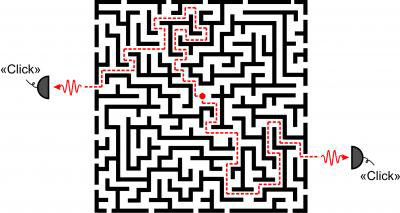| Dec 20, 2012 |
The paths of photons are random - but coordinated
|
|
(Nanowerk News) Researchers at the Niels Bohr Institute have demonstrated that photons (light particles) emitted from light sources embedded in a complex and disordered structure are able to mutually coordinate their paths through the medium. This is a consequence of the photons' wave properties, which give rise to the interaction between different possible routes. The results are published in the scientific journal, Physical Review Letters ("Nonuniversal Intensity Correlations in a Two-Dimensional Anderson-Localizing Random Medium").
|
|
The real world is complex and messy. The research field of photonics, which explores and exploits light, is no exception, and in, for example, biological systems the statistical disorder is unavoidable.
|
 |
| The illustration shows how the scattering of photons occurs in a complex photonic medium. Two photons are emitted from a light source in the center and move through a labyrinth to illustrate complex scattering. The photons take different paths through the medium, but they are interdependent in the sense that that the chance of observing a photon at one outlet is increased if a photon is observed at the other outlet. (Image: David García, Niels Bohr Institute)
|
|
Drunken people and photons
|
|
"We work with nanophotonic structures in order to control the emission and propagation of photons. We have discovered in the meantime, that inevitable inaccuracies in the structures lead to random scattering. As a consequence, the transport of photons follow a random path – like a drunken man staggering through the city's labyrinthine streets after an evening in the pub," explains David García, postdoc in Quantum Photonics at the Niels Bohr Institute at the University of Copenhagen.
|
|
If we continue with this analogy, then it is not certain that just because one drunken man comes home safely, then a whole crowd of drunken people spreading out from the pub will also find their way through the city's winding streets. There is no relationship between the different random travellers.
|
|
But there is when you are talking about photons. They can 'sense' each other and coordinate their travel through a material, according to new research.
|
|
"We have inserted a very small light source in a nanophotonic structure, which contains disorder in the form of a random collection of light diffusing holes. The light source is a so-called quantum dot, which is a specially designed nanoscopic light source that can emit photons. The photons are scattered in all directions and are thrown back and forth. But photons are not just light particles, they are also waves, and waves interact with each other. This creates a link between the photons and we can now demonstrate in our experiments that the photons' path through the material is not independent from the other photons," explains David García.
|
|
Spectroscopy of complex materials
|
|
By analysing the path of the photons through the medium valuable insight is potentially gained about microscopic complex structures.
|
|
"The method could be a new way to measure the spatial properties of complex disordered materials, like biological tissue, and since the light sources are very small, you will be able to place them without destroying the material and you have the potential for very high spatial resolution," explains David García.
|

